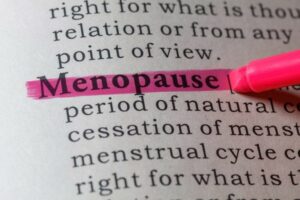EXPERIENCING THESE SYMPTOMS OF MENOPAUSE? WHEN TO GET TREATMENT
For many women, menopause is a part of life that is always looming on the horizon. Often, they could start noticing early signs of menopause in their 40s or even mid-30s. The symptoms of hormonal imbalance associated with menopause only intensify diminishing a woman’s quality of life.
If you have started seeing some early signs or feeling intense symptoms of menopause, a practitioner certified in hormone balance can help you understand why you’re feeling this way and what you can do to start feeling like your best self again.
WHAT IS MENOPAUSE?
Menopause refers to the time in your life when your menstrual cycle stops (menopause is officially diagnosed after 12 consecutive months without a menstrual period). People often associate a woman’s 50s with the age of menopause. While the average age of women beginning menopause in the US is 51, it can also begin in your 40s. Not only that, but you can start to feel the negative effects of hormonal imbalance earlier than that with a condition known as perimenopause.
Perimenopause, by definition, means “around menopause” and is when your body starts to make a transition towards menopause. Think of it as a preview to menopause. You would start to experience fluctuating hormone levels (mostly estrogen) and the resulting symptoms, but your body would still be undergoing menstrual cycles (although they would likely start to become irregular). Here are some of the most common perimenopause symptoms, many of which closely mirror the symptoms of menopause:
- Irregular Periods
- Hot Flashes
- Lower Libido
- Mood Swings
- Bone Density Loss
- Sleep Loss
- Vaginal Dryness
- Bladder Issues
- Fertility Issues
- Painful Intercourse
Aside from the irregular periods and fertility issues, these symptoms will not only continue during menopause, but they may become more intense or frequent.
MENOPAUSE CAUSES
Aging is the most common cause of perimenopause and menopause, but there are still other causes as well. Early menopause can also be the result of chemotherapeutic drugs, exposure to radiation, and even smoking. Menopause can also be caused by certain surgeries, such as radiation of the ovaries and pelvis or removal of at least one ovary (oophorectomy). This leads to a condition known as surgical menopause, and it escalates hormonal imbalance very quickly.
WHAT ARE THE SYMPTOMS OF MENOPAUSE?
Menopause symptoms align almost identically with the symptoms of perimenopause. Let’s take a closer look at how these adverse symptoms can affect your day-to-day life and make it hard for you to feel your best.
IRREGULAR MENSTRUATION
Irregular menstruation may appear during perimenopause as your body begins to transition towards menopause. Irregular menstruation not only refers to the length of time between periods, but the viscosity of the flow as well. A perimenopausal woman can experience a consistent change of her menstrual cycle that ranges from 7 to 60 days. The fluctuations that occur on that spectrum are a good indicator of a woman’s progression into menopause.
VAGINAL DRYNESS AND DISCOMFORT
Vaginal dryness is a symptom that can begin in perimenopause and continue through menopause. The dryness occurs when vaginal tissues lose lubrication and elasticity as a result of declining estrogen levels. This symptom can leave women more likely to suffer from vaginal and urinary infections and can even lead to vaginal atrophy if left unchecked. Understandably, vaginal dryness can also lead to various forms of sexual dysfunction such as pain during intercourse, decreased sensation, and low libido.
HOT FLASHES
Hot flashes are defined as briefly and suddenly feeling hot. Each individual experiences hot flashes a little differently. Hot flashes, also known as hot slushes, are often a result of the glands trying to overcompensate for declining estrogen levels by flooding your body with other hormones. Hot flashes are often accompanied by a flushed face and sweating. While they can occur naturally, hot flashes can also be activated by things like hot weather, stress, alcohol, smoking, and caffeine.
SLEEP LOSS
Hot flashes are just one of the symptoms of menopause that can contribute to sleeping issues. Along with night sweats, they can lead to interrupted and poor sleep. Hormonal imbalance doesn’t stop there either. Women who have gone through menopause are as much as 2 to 3 times more likely to have sleep apnea. Sleep loss can lead to increased stress, which can then lead to more sleeping difficulties. These menopause symptoms often feed off one another and make it difficult to have a happy and productive day.
EMOTIONAL CHANGES
With consistent hormone changes occurring almost moment to moment, it’s understandable that a woman’s mood may fluctuate as well. Estrogen and progesterone are the primary culprits, slowing down the body’s production of serotonin and, therefore impacting mental and emotional health. This can mean an increase in irritability, stress, anxiety and even contribute to depression. These factors may lead to sleep issues, further enhancing the rollercoaster of emotions and mental distress.
COGNITIVE ISSUES
Have you found it difficult to focus? Do you find it harder to remember the little details? Fluctuating levels of estrogen, particularly estradiol, have been shown to affect cognitive function. Estradiol plays many key roles in brain function, so it’s no surprise that reduced cognitive function or “brain fog” is a well-known symptom of menopause. Unfortunately, this is another symptom that can be intensified by sleep disturbances and increased stress.
PHYSICAL CHANGES
Now that we’ve spent time on the toll that menopause symptoms take on your emotional well-being, let’s talk about some of the physical symptoms and changes that you may start noticing. Have you found it harder to maintain your ideal weight? Weight gain is a menopause symptom that people tend to pick up on pretty quickly. After all, it’s one of the more tangible effects of hormonal imbalance; it’s a change that you can see. Some of the other symptoms of menopause that you can see or feel include:
- Thinning Hair or Hair Loss
- Increased Hair Growth (in new areas, like the face)
- Joint and Muscle Aches
- Dry Skin
- Breast Tenderness
- Dry Eyes
- Headaches
- Dry Mouth
Once again, imbalance levels of estrogen seriously disrupt the body’s ability to function properly. In these cases, you would see and feel these negative effects in your daily life.
INCREASED RISK OF CERTAIN HEALTH CONDITIONS
Estrogen also protects your body against more serious health conditions. As estrogen diminishes, especially in post menopause, the risk of suffering from these conditions can increase. Post menopause marks the time in a woman’s life after menstruation has completely stopped and estrogen levels remain low instead of fluctuating.
The first condition that carries an increased risk is cardiovascular disease. Heart attack, stroke, and heart disease are all more likely as estrogen levels drop. When you also factor in the weight gain that often results from hormonal imbalance, the risk of cardiovascular disease increases even more.
Low estrogen levels also increase the risk of osteoporosis. Remember that loss of bone density is something that can be experienced as early as perimenopause, and it has been estimated that you can lose up to 25percent of bone density after menopause. That kind of bone loss could open you up to increased risk of bone fractures in addition to the increased risk of osteoporosis.
MENOPAUSE DIAGNOSIS
If you have gone at least 12 months without menstruation, then you can officially be diagnosed with menopause. Whether you’re starting to experience menopause symptoms in perimenopause or you’re already officially in menopause itself, a qualified practitioner could test your various hormone levels through such methods as blood and saliva. Having that big picture of your hormonal health would allow you to plan a path forward towards better health and vitality.
TREATMENT FOR SYMPTOMS OF MENOPAUSE
There is a very good chance that your path towards renewed health would include some form of hormone therapy. Next, you will discover what options you have to relieve menopause symptoms and restore wellbeing.
HORMONE THERAPY FOR MENOPAUSE SYMPTOMS
In the past, women experiencing menopause symptoms were often treated with a combination of synthetic progesterone (progestin) and estrogen. However, hormone replacement therapy (HRT) has come a long way. Today, bioidentical hormones are compounded from plant-derived resources and designed to an identical match in both structure and function to the hormones in the human body. This form of therapy is known as bioidentical hormone replacement therapy, or BHRT. BHRT mitigates many of the risks classically associated with synthetic hormones (especially synthetic forms of estrogen and progesterone). This is because the structural match of bioidentical hormones allows for a proper fit to the hormone receptors in your body. When paired with the right delivery method and placement, BHRT is seamlessly delivered throughout the body, restoring balance in the same fashion as human endogenous hormones (or the hormones produced by the body).
FORMS OF BIOIDENTICAL HORMONE THERAPY FOR MENOPAUSE
For decades, the two most common forms of treatment for the symptoms of menopause have been pills and creams. Both options require daily attention, which certainly has its drawbacks. For example, if you misplace your medications, forget to take or apply frequently, or run out before your next refill, you may experience detrimental side effects (i.e., a return of uncomfortable symptoms) until you are able to replenish your supply.
Creams also carry a risk of exposure among the people around you, including children and pets. If someone accidentally comes in contact with an area where the cream has been applied—even a hand towel in a shared bathroom—their hormone levels may be altered, particularly if exposure occurs frequently.
Patches are another common option for BHRT. However, patches notoriously fall off when sweating or in the shower leading to gaps in your dose and diminishing the effectiveness of each treatment cycle.
Pellet hormone replacement therapy is another option for hormone delivery. Use of pellets dates back to the 1930s and in recent years has become the preferred method of hormone replacement therapy because of its convenience.
Many people choose pellets because once inserted, you get a steady dose of hormone over the treatment cycle. That means no daily reminders to take a pill or slather on a cream. No risk of exposure for the people and pets around you, and no risk of loss when you sweat or swim. It’s inserted and you’re done! You can live your life and feel your best without worry. And your next appointment is typically scheduled at that just right moment when your dose is running out—typically every 3 to 6 months (dosing and treatment cycles are based on factors unique to each patient).
SYMPTOM RELIEF
Whichever method you choose, BHRT is clinically researched and shown to relieve symptoms of menopause. You can restore hormone balance and enjoy better sleep, stabilized moods, relief hot flashes and more. If you have been struggling with any combination of menopause symptoms, this could be just what you need to get your life back.
DISEASE PREVENTION
The closer you get towards post menopause, the higher the risks become of suffering from diseases like osteoporosis and various forms of cardiovascular disease. Depleted estrogen levels wreak havoc on the body’s ability to protect you from certain diseases. In fact, new research has shown that hormone balance, particularly estrogen, reduces risk of glaucoma too.
GET MENOPAUSE RELIEF CURATED JUST FOR YOU
Why settle for synthetic hormones with inexact doses when you can go in with a fully customized plan that has been laid out by an accurate measurement of your hormone levels?
CUSTOM TREATMENT PLANS FOR MENOPAUSE
The qualified providers at Balanced Health have been trained to look at your whole-body health, review your labs, medical history, symptoms, and lifestyle to develop a treatment plan designed to achieve true optimization for your personal health. Hormone optimization is unique to each individual–don’t accept a cookie-cutter treatment plan.
HOW DO I GET STARTED?
The care team at Balanced Health is ready to help you feel better! During your initial consultation we will discuss the best options for your treatment, and we will customize a treatment plan that meets your needs. Your next step is to contact us and set up a complimentary consultation so that we can discuss your concerns, and help you start your journey on the way back to feeling like yourself again!







